ISSN ONLINE(2319-8753)PRINT(2347-6710)
ISSN ONLINE(2319-8753)PRINT(2347-6710)
MD. Mansoor Ahamed¹, J.Kannakumar², P.Mallikarjuna reddy³
|
| Related article at Pubmed, Scholar Google |
Visit for more related articles at International Journal of Innovative Research in Science, Engineering and Technology
Many agricultural commodities and food commodities are being kept in commercial cold storages. Problems associated with these cold storages are during power cuts for cold storage leads to an increase in temperature and can result in the loss in quality and value of stored products. This paper proposes the use of a passive system integrated into the walls of the cold storage facility to limit the rise in temperature due to power loss. Hence useful for commercial establishments as presently there are frequent power cuts.
Keywords |
| Phase change material (Ethylene Glycol), Poly Urethane Foam, Vapour Compression Cycle |
INTRODUCTION |
| Now-a-days power cuts are very often due to accidents, or could be due to implementation of demand side management schemes (DSM) to shift power usage to avoid high loads by the electricity supplier, or by the user to shift their electricity usage to off-peak pricing periods (electrical load shifting) and it is important to maintain regular temperatures inside cold storage facilities and cold transport vehicles (17, 2010). Most frozen and chilled foods are sensitive to temperature fluctuations. A major contribution to the heat loadings for a cold store comes from heat penetrating the walls. The refrigeration system removes this heat load, but if there is a power failure, cooling is not provided to the stored product (16, 2009). Thermal Energy storage systems (TES) will use phase change materials for storage of heat and cold at shifted time. Phase change material (PCM) melts within a narrow temperature range, and absorbs a large amount of energy while in the transition state, thus minimizing the rise in the environment temperature. PCM with a suitable melting temperature may be used to provide thermal capacity to maintain suitable internal temperature during power failure. (15, 2010) PCM may also be used in load shedding applications to shift electricity usage to an optimum time. Many Cold Thermal Energy Storage (CTES) systems have gained attention in recent years. |
EXPERIMENTAL SETUP |
2.1 Design and operation of components of cold storage plant: |
| The salient components of vapour compression refrigeration system used in Indian cold storage system are: evaporator, compressor, condenser and manually operated expansion valve. A typical schematic diagram of the refrigeration system is shown below in figure 1. |
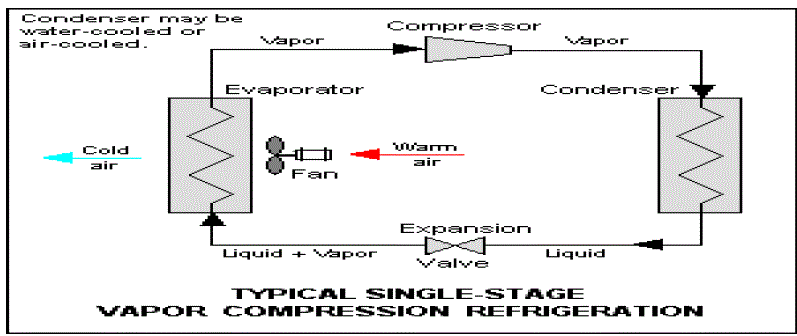 |
| 2.1.1 Evaporator: It is in the evaporators where the actual cooling effect takes place in the refrigeration and the air conditioning systems. The evaporators are heat exchanger surfaces that transfer the heat from the substance to be cooled to the refrigerant, thus removing the heat from the substance. The evaporators are used for wide variety of diverse applications in refrigeration and air conditioning processes and hence they are available in wide variety of shapes, sizes and designs. They are also classified in different manner depending on the method of feeding the refrigerant, construction of the evaporator, direction of air circulation around the evaporator, application and also the refrigerant control. In the evaporator the refrigerant enters at very low pressure and temperature after passing through the expansion valve. This refrigerant absorbs the heat from the substance that is to be cooled so the refrigerant gets heated while the substance gets cooled. Even after cooling the substance the temperature of the refrigerant leaving the evaporator is less the than the substance. The refrigerant leaves the evaporator in vapor state, mostly superheated and is absorbed by the compressor. This is one of the major components of the refrigeration plant. Improper design and selection leads to low suction pressure and resultant high energy consumption. |
| 2.1.2Compressor: The heart of the vapour compression refrigeration system in cold storage is compressor. It raises the pressure of the refrigerant gas to the necessary condensing pressure corresponding to condenser temperature. It was found from the survey of different cold storage that water used to cool the compressor is not of standard quality. This water is hard in nature, containing many dissolved salts. These salts deposit on the surface of the cooling jacket around the compressor causes poor heat extraction from the compressor cylinder. The resultant insufficient cooling of the compressor results in high discharge temperature of the refrigerant gas, which ultimately increases electrical power consumption and adversely affects the quality of lubricating oil. Therefore, it is recommended that soft water should be used to cool the compressor. |
| 2.1.3 Condenser: Liquefaction of the refrigerant gas sucked out of the evaporator by the compressor is done in condenser. In the Indian cold storage industry, atmospheric type of condenser is used, wherein a spray system divides the water flow over a number of horizontal tubes in which refrigerant condenses. The cooling effect in this system totally depends upon the atmospheric temperature and relative humidity. However, the evaporative condensers are considered to be advantageous over atmospheric one because in a hot and humid weather, it is possible to give the lowest condenser pressure and therefore lower power consumption. The wetting of evaporative condenser requires 1 % of the total power consumption and reduces the energy consumption by 30 % as compared to air-cooled condenser. For analysis of the concept of phase change material which improves the cooling stability in cold storages, a model cold storage by using phase change material is constructed. In our project we have used ethylene glycol along with water as a phase change material. The classification of PCM’s and their importance are discussed below. |
| 2.2 PHASE CHANGE MATERIALS |
| A phase-change material (PCM) is a substance with a high heat of fusion which, melting and solidifying at a certain temperature, is capable of storing and releasing large amounts of energy. Heat is absorbed or released when the material changes from solid to liquid and vice versa; thus, PCMs are classified as latent heat storage (LHS) units. |
| 2.2.1 Characteristics and classification |
| PCMs latent heat storage can be achieved through solid–solid, solid–liquid, solid–gas and liquid–gas phase change. However, the only phase change used for PCMs is the solid–liquid change. Liquid-gas phase changes are not practical for use as thermal storage. Liquid–gas transitions do have a higher heat of transformation than solid–liquid transitions. Solid–solid phase changes are typically very slow and have a rather low heat of transformation. PCM stores 5 to 14 times more heat per unit volume than conventional storage materials such as water, masonry or rock. The classification of PCM is shown in figure 2. |
| 2.2.2 Some of the important properties required for PCM are |
| High latent heat of fusion per unit mass, so that a lesser amount of materials stores a given amount of energy. |
| High thermal conductivity so that the temperature gradient required for charging the storage material is small. |
| High density, so that a smaller container volume holds the material to obtain compact encapsulation. |
| A melting point in the desired operating range of temperature as per the application. |
| The phase change material should be non poisonous, non-flammable, and non explosive. |
| No chemical decomposition, so that the system life is assured. |
| No corrosiveness to the encapsulation material. |
| In our model we have used ethylene glycol as a phase change material. The physical and chemical properties of ethylene glycol are shown below. |
 |
| 2.2.3 Properties of ethylene glycol |
| 2.2.3.1 Historical aspects and natural occurrence |
| Ethylene glycol is produced from ethylene. Ethylene oxide reacts with water to produce ethylene glycol according to the chemical equation: |
| C2H4O + H2O → HO–CH2CH2–OH |
| 2.2.3.2 Antifreeze |
| Due to its low freezing point ethylene glycol resists freezing. Ethylene glycol disrupts hydrogen bonding when dissolved in water. Pure ethylene glycol freezes at about −12 °C (10.4 °F), but when mixed with water molecules forms a solid crystal structure, and therefore the freezing point of the mixture is depressed significantly. The minimum freezing point is observed when the ethylene glycol percent in water is about 70%, as shown below. |
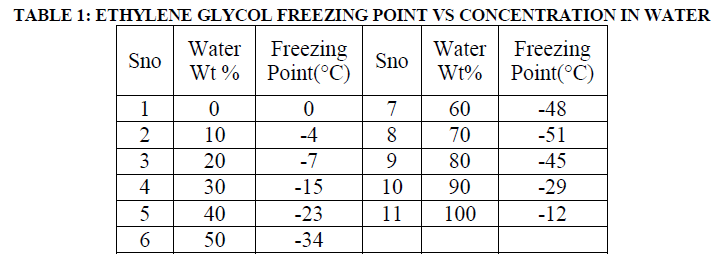 |
| However, the boiling point for aqueous ethylene glycol increases monotonically with increasing ethylene glycol percentage. Thus, the use of ethylene glycol not only depresses the freezing point, but also elevates the boiling point such that the operating range for the heat transfer fluid is broadened on both ends of the temperature scale. The increase in boiling temperature is due to pure ethylene glycol having a much higher boiling point and lower vapor pressure than pure water. |
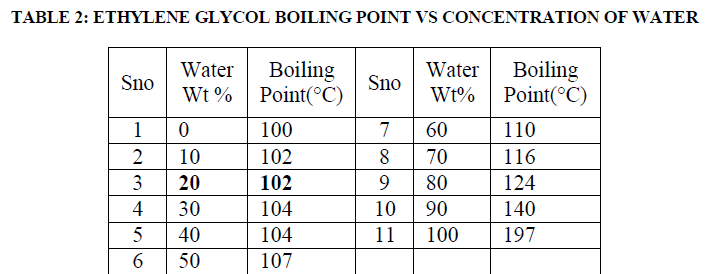 |
| 2.2.3.3 Physical Properties |
| Ethylene glycol is a clear, colourless, odourless liquid with a sweet taste. It is hygroscopic and completely miscible with many polar solvents such as water, alcohols, glycol ethers, and acetone. Its solubility is low however, in non polar solvents, such as benzene, toluene, dichloroethane, and chloroform. Following are some of the physical properties of ethylene glycol as shown in table 3. |
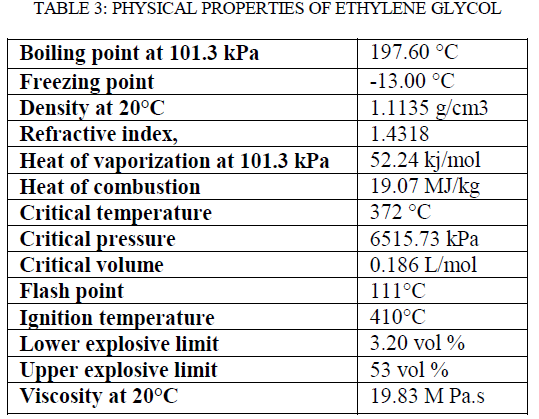 |
| Ethylene glycol is difficult to crystallize; when cooled, it forms a highly viscous, super cooled mass that finally solidifies to produce a glass like substance. The widespread use of ethylene glycol as antifreeze is based on its ability to lower the freezing point when mixed water. The physical properties of ethylene glycol- water mixtures are therefore, extremely important in this regard. |
| 2.2.3.4 Chemical Properties |
| The ethylene glycols (commonly called diols) are dihydirc alcohols that have an aliphatic carbon chain. The two hydroxyl groups result in high water solubility and hygroscopicity and provide reactive sites. The heavier glycols exhibit some of the properties of ethers because of the ether linkage in their molecular structure. The reaction of the ethylene glycols are similar to those of the monohydric alcohols in which the hydrogen group is replaced by halogens, is esterifies of forms ethers, etc. |
| 2.2.3.5 Concept of Phase Change Energy Storage |
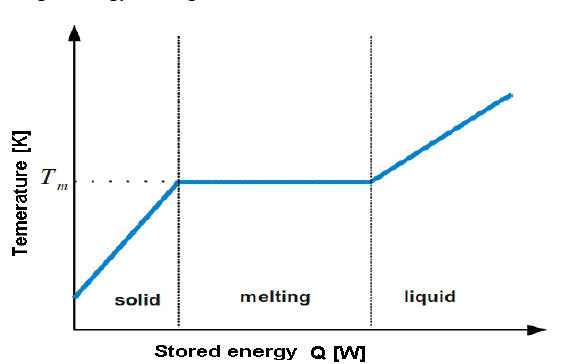 |
| The latent heat storage (LHES) or phase change materials (PCM) absorb and release heat as it undergoes a change in phase from solid to solid, solid to liquid or liquid to gas or reverse. The energy stored during the phase change process is called “latent heat” or “heat of fusion”. As the materials cool off (at night or on cloudy days) they subsequently release the stored heat while solidifying in the same fashion. The phase change takes place without a change in the temperature of the material itself. Figure (3) depicts the mechanisms of heat absorption and release in LHES materials. From the graph it is clearly understood that at the melting point, as the temperature of the PCM rises, their chemical bonds break up gradually as the material changes phase from solid to liquid. The phase change is a heat seeking (endothermic) process and therefore, the PCM absorbs large amount of heat without getting hotter, i.e. while storing heat, the temperature of the PCM stays nearly constant until the melting process completed. |
| 2.3 Design of Cold Cabin: |
| For the application of PCM to improve temperature stability during power loss in cold store, a vertical cabin dimensions 0.2794m H x 0.2794mWx0.325m D (11”x11”x11”) and a storage volume of 25.7 L was used. Anodized aluminium panels filled with PCM (a ethylene glycol solution with a melting point of -23°C) were placed against the walls of the cold cabin in the arrangement shown in Figure. The PCM in an aluminium panels with dimensions of0.0254x0.33x0.38m (thkXwideXheight) i.e;1”x13”x15” contained 3 liters of ethylene glycol and 12 liters of water as a PCM occupying a volume of 4.735 L was used for experimental investigation. The PCM panels were placed vertically against the entire walls to minimize the amount of usable storage space lost as shown in Figure 1. This PCM panels was covered entirely with poly urethane foam panels of dimensions 0.05x0.43x0.43m (thkxwidexht). This will reduce the heat transfer from outside to inside the cabin as shown in figure. As evaporator coil and phase change material (PCM) are present in one panel, the PCM will absorbs the energy as evaporator coil cools and stores the energy by changing its phase. During power cuts or off peak time the pcm will releases its energy and maintains the cold cabin at constant require temperature for -8°C for about 7-8 hours depending upon the outside condition as it is proved by experiment. Thus a small difference in temperature can be used for storing energy and releasing the stored energy. The cold cabin was allowed to reach a quasi steady-state condition, where the air temperature cycled between - 19°C and -23° C due to the compressor switching ON and OFF during normal operation. The electrical power to the cold store was then switched "off" to allow the temperature in the cold cabin to rise due to heat penetration through the walls. This was done for the cold cabin with and without PCM to study the effect of utilizing PCM panels in the cold cabin to limit the temperature rise during loss of electrical power. In order to avoid the above stated problem, in this paper it is clearly analysed experimentally that the thermal storage capacity can be improved by using phase change material panels incorporated in the walls of the cold storage. |
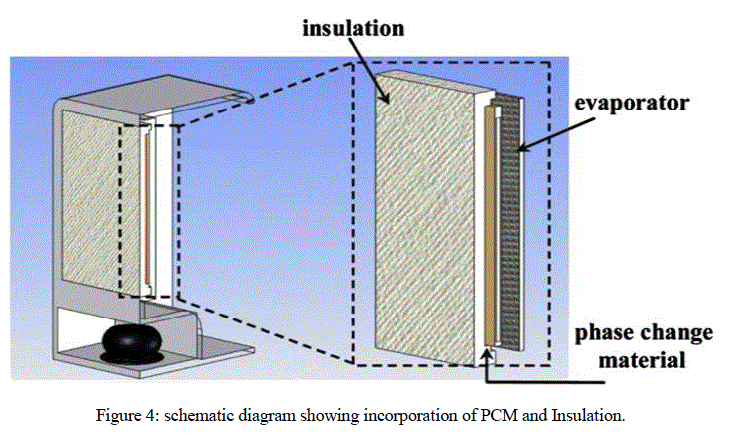 |
| 2.3.1 Design details of model of cold storage plant using (PCM) phase change material |
| Mass of refrigerant (R134a) (m) = 250grm. |
| 1. Compressor details:- |
| Compressor Power = 0.167 H.P |
| 1 H.P = 746 W |
| Therefore Power = 0.167×746=124.582 W |
| We use Reciprocating piston type compressor. The specifications of the compressor are as follows: |
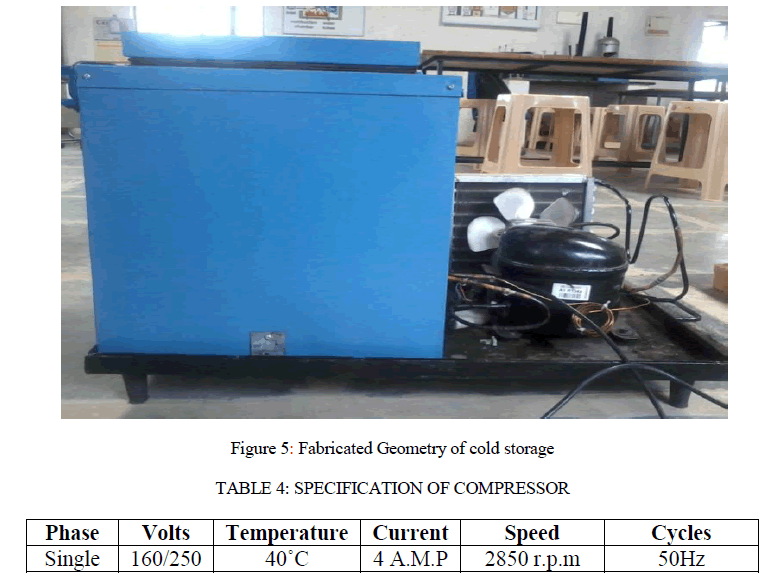 |
| Theoretical tonne of refrigeration system is 0.5 Ton |
| 2. Condenser fan details:- |
 |
| 3. Condenser details:- |
| Fine type 9 inch double row condenser is used |
| Heat extracted in the condenser = m cp ΔT |
| = m cp (T2 – T1) |
| = 0.250×129.98(80-50) |
| = 974.85 KJ |
| 4. Expander details: - It is used as expansion device in small capacity hermetic sealed refrigeration unit such as domestic refrigerators water coolers, room air-conditioners and freezers. It is cupper tube of small internal diameter and of varying length depending upon the application. The inside diameter of tube used in refrigeration work is generally 0.5mm to 2.25mm and the length varies from 0.5m to 5m.It is installed in the liquid line between the condenser and the evaporator. In this operation the liquid refrigerant from the condenser enters into the capillary tube. Due to the frictional resistance offered by the small diameter tube, the pressure drops. Since the frictional resistance is directly proportional to the length and inversely proportional to the diameter, therefore longer the capillary tube and smaller it’s inside diameter, greater in pressure drop created in the refrigerant. |
| Diameter of capillary tube = 0.050 inch. |
| Length of capillary tube = 5ft. |
| 5. Evaporator:-The shell and coil evaporator are generally used as dry expansion evaporator to chill water. The cooling coil is continuous tube that can be in the form of single or double spiral. The shell may be sealed or open. The sealed shell is usually found in shell and coil evaporators used to cool drinking water. |
| Length of the evaporator coil = 30ft. |
| Diameter of the evaporating coil = 1/4 inch |
| 6. Capacity of the cold storage plant. |
 |
| 7. Phase change material used is Ethylene Glycol |
 |
EXPERIMENTAL RESULTS |
| The desired working model of cold storage plant using (PCM) phase change material is successfully designed and fabricated. It is also successfully tested for working. Experimental application of PCM into a cold storage has shown that the temperature rise during loss of power is limited. With PCM, the air temperature is kept constant at -8°C for 8 hours, compared to without PCM where the air temperature rises continuously and rises above -8°C in just 1 hour as shown in the figure 6. The PCM temperature rises slowly as the PCM melts over this 8 hour period. Once the PCM has finished melting, the air and PCM temperatures rise steeply. |
| The model is tested successfully for its working. The following is observed during the testing. |
| The duration of cooling the PCM 24 Hours. |
| Temperature of the cold chamber -250C |
| Temperature reducing rate at 10C per hour up to -80C and from there the temperature will remains constant for about 7 hours and again temperature will raises steeply. |
 |
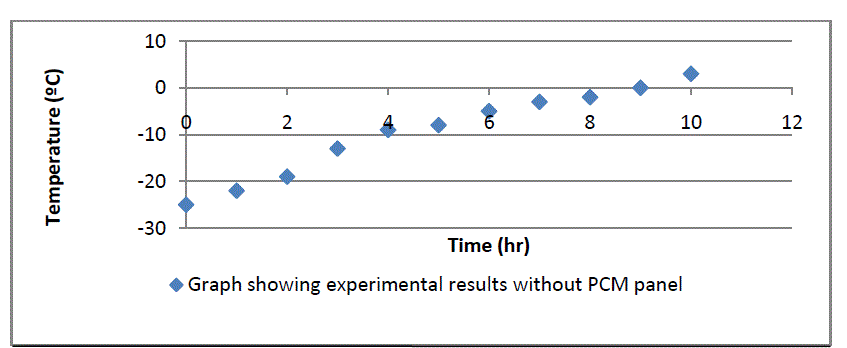 |
CONCLUSION |
| Experiment concluded that use of PCM in the walls of a cold store can limit the rise in air temperature inside the cold storage during loss of electricity. As the PCM melts, it absorbs the thermal load that enters the cold storage space, thus limiting the rise in the cold store temperature. The experimental results shows that PCM could be utilised to limit temperature rises during loss of electrical power, which may occur due to an accidental power loss or done purposely to achieve electrical load shifting. The modelling was extended to predict the temperature changes in a large cold store and the results also indicate that PCM can limit the rise in air temperature. This modelling work can be extended to investigate the effects of increasing the surface area, and positioning of PCM panels in different way. It is also observed that when power supply is off this technique is cheapest when compared to other alternate power sources. |
References |
|